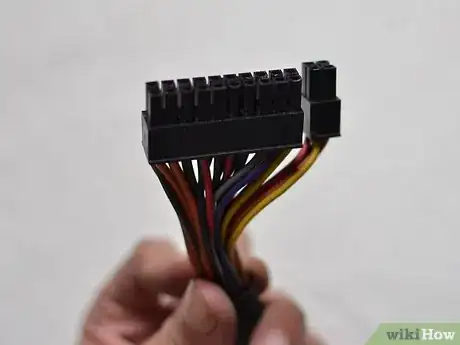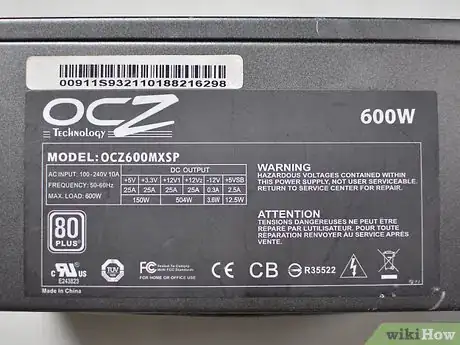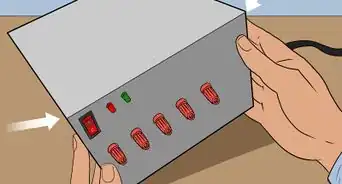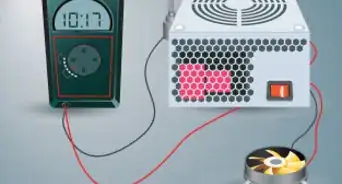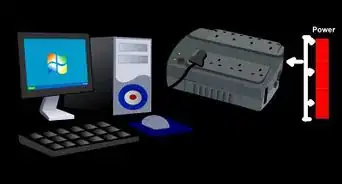wikiHow is a “wiki,” similar to Wikipedia, which means that many of our articles are co-written by multiple authors. To create this article, 32 people, some anonymous, worked to edit and improve it over time.
This article has been viewed 416,533 times.
Learn more...
The power supply unit (PSU) is one of the few items in an electrical device that will affect the reliability of your entire system. It's often the most undervalued, under-appreciated component within any device, yet one of the first components to cause failure.
This article focuses on the factors to look for when purchasing a PSU for a personal computer, but it may be applied to any application needing a regulated PSU. When following this guide, take into account your own application, and appropriately weigh each factor.
Steps
-
1Determine the wattage you need. Use a PSU calculator web page or software to help determine your requirements. Even better is to find a review of a similar system that measures power consumption. As that consumption is measured at the wall, multiply by the review system's power supplies efficiency to get the output. (If you don't know, 0.82 will be close or slightly pessimistic.) Don't purchase a PSU just above your requirements. The maximum efficiency of any power supply is in the range of 40%-60% load. Also, PSUs age, losing power over time. Purchase a PSU that will take you through your next few upgrades, over a multiple-year period.
-
2Research which connectors you need. Newer PSUs will often provide both a 24-pin ATX connector that doubles as a 20-pin connector. Higher-end models may only provide a 24-pin connector, and lower-end models may provide just a 20-pin connector. Typically, most Pentium 4 and Athlon 64 CPU-based motherboards (and earlier) will require a 20-pin ATX connector, while newer motherboards require a 24-pin ATX connector. Also, most PSUs will have a 4-pin auxiliary 12V connector for motherboards, and some will have an 8-pin that doubles as a 4-pin and only high-end PSUs will have one or more 6-pin or 8-pin PCI-E connectors for video cards.Advertisement
-
3Look for PSUs with high-efficiency ratings. And, ones rated under load temperatures, not room temperatures. Anything 80% and above is good. At 83%, approximately 17% of the wattage is lost as heat. Therefore, a PSU that may be advertised as a 500W PSU, will actually be drawing almost 600W at the wall. Efficiency drops over time and during the life of the PSU. A year-old PSU is most likely not capable of producing the same amount of energy it once did when it was new. The "80 Plus" Certification shows that the power supply has been tested to have 80% efficiency at every load. There are higher tiers of 80 Plus that show even higher efficiency such as 80+ Bronze or Silver. Considering electricity cost saved, it might be worth to buy a significantly more expensive PSU than what you considered first.
-
4Determine the robustness of the PSU. How well does the PSU handle changes in current? Although not a guarantee, there's a strong correlation between weight and quality: bigger components (i.e., capacitors) equate to a more tolerant, reliable PSU. This is one downside to a 120mm fan: while it does provide quieter cooling, the components to be cooled must be more tightly packed. If you don't care about noise, an 80mm cooling fan in the traditional place on the rear of the PSU may offer better value.
-
5Check the number of rails. Just as your house's fuse box includes both a large main breaker and a smaller circuit breaker per circuit to ensure the smaller-branch circuit wires do not overheat, high-capacity PSUs divide their output into multiple "rails," each with a smaller current limit. The relevant safety standard requires a 20A limit, which is quite generous, given that the wires are smaller than those used in your house to carry 15A. (But there's the advantage that the wires aren't hidden in walls, so they're cooled better, and you'll smell it if something starts burning.) This, however, makes connecting the PSU more complex; in addition to not overloading it overall, you have to avoid overloading each rail, or it will shut down. A good power supply will make that easy by providing rails totalling much more than the total PSU rating. A cheaper alternative is to provide just enough rails to total the overall capacity, which makes it difficult to use all of a power supply's capacity. (This may be a clue that the PSU is incapable of delivering its full-rated capacity.) An even cheaper alternative, which has become quite popular, is to eliminate all of the safety circuitry and produce a "single-rail" power supply that can deliver all of its output on any wire. This is technically in violation of the ATX-power-supply specification but has not proved to be a safety problem in practice, and is preferred by many people. A single-rail design isn't itself a sign of a low-quality PSU.
-
6Get a modular PSU. It will help eliminate extra wires to get in the way of cooling. Ignore the claims that modular cables create more resistance due to corrosion of contacts. The additional resistance is negligible.
-
7Compare the amperage of each voltage. A PSU's wattage rating isn't conducive to determining amperage at any specific voltage. All PSUs will have a sticker with their rated amperage at each voltage level. This information should be provided when purchasing a PSU from an online vendor and visible on the unit's retail box. As mentioned above, modern computers are 12V-heavy loads. A 500W PSU may sound adequate, but if its 12V amperage is in the low 20s or less (12V times 25A is 300W), it may not be able to power a modern computer.
Community Q&A
-
QuestionHow do I know how much wattage is too much for my computer?
 DenneiskTop AnswererYou can never have too many watts, but if you want to save power and money, tally up the minimum wattage for all your installed components and round up. For example, if your sound card needs at least 100W, your GPU 150W, and other miscellaneous components need 100W combined, then you can settle down on 500W to cover the power requirement.
DenneiskTop AnswererYou can never have too many watts, but if you want to save power and money, tally up the minimum wattage for all your installed components and round up. For example, if your sound card needs at least 100W, your GPU 150W, and other miscellaneous components need 100W combined, then you can settle down on 500W to cover the power requirement. -
QuestionIs the charger the same for all laptops?
 Community AnswerNot usually, no. Sometimes laptops of the same brand that are similar models will have compatible chargers, but for the most part they are all different.
Community AnswerNot usually, no. Sometimes laptops of the same brand that are similar models will have compatible chargers, but for the most part they are all different. -
QuestionI want to buy a computer power supply. How can I be sure it's legit?
 Community AnswerBefore making your purchase, use a power supply calculator to count the total volts, watts and amperage for a suitable PSU. Buy a well-known brand (Seasonic, Thermaltake, Silverstone, etc.) from a reputable dealer with favorable reviews.
Community AnswerBefore making your purchase, use a power supply calculator to count the total volts, watts and amperage for a suitable PSU. Buy a well-known brand (Seasonic, Thermaltake, Silverstone, etc.) from a reputable dealer with favorable reviews.
Warnings
- Check the warranty. Compare each manufacturer's guarantee, return policy, and customer-service history. There are some PSU manufacturers that release great products with horrible support, and vice versa.⧼thumbs_response⧽
- PSU manufacturers and distributors have no obligation to any standard of rating wattage. Many 'value' PSUs may not actually output the wattages they claim under real-world conditions. It's possible for a 500W 'value' PSU to produce less power than a quality PSU sold at 350W. Thus, 'upgrading' a PSU but selecting a low-end model, may actually be a downgrade!⧼thumbs_response⧽
- Never test a power supply with a paperclip. This is very dangerous for both the supply and the user because the paperclip conducts electricity.⧼thumbs_response⧽
- Never open a power supply, in spite of information on the internet advising otherwise. Such articles are intended for qualified power supply repair technicians only. A power supply contains capacitors that hold a charge even while a computer is turned off; this discharge can seriously injure the user.⧼thumbs_response⧽
- High-volume, low-quality manufacturers often purchase designs from other companies for use in their own products. These 'carbon-copy' designs are often of low quality. In turn, they release their carbon-copy product with additional bells-and-whistles and a different company 'label' to entice customers. They may even charge a premium for the additional features. If you're serious about purchasing a reliable PSU, only buy one from a manufacturer that designs a majority of their units.⧼thumbs_response⧽

